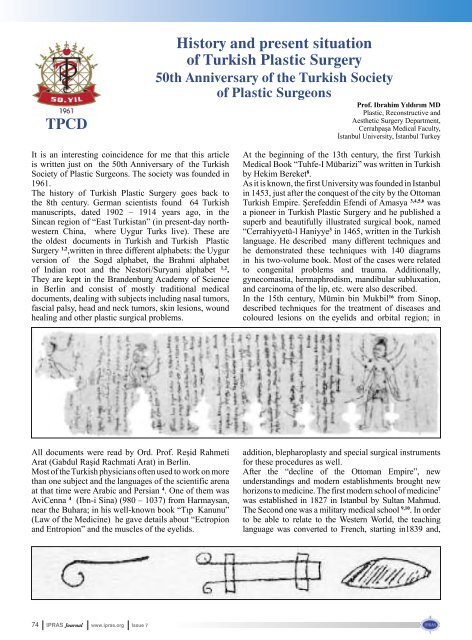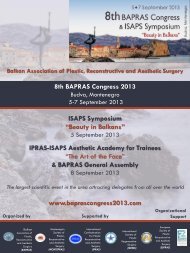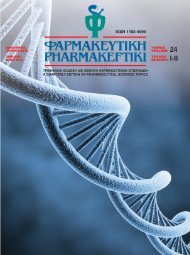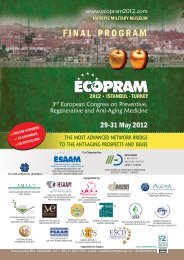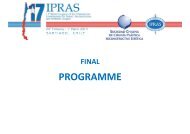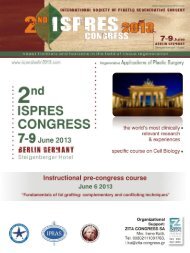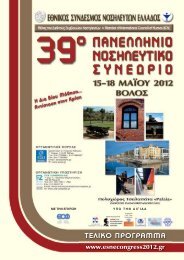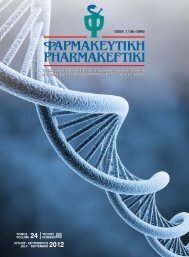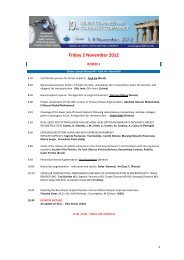TPCDHistory and present situationof Turkish Plastic Surgery50th Anniversary of the Turkish Societyof Plastic SurgeonsProf. Ibrahim Yıldırım MDPlastic, Reconstructive andAesthetic Surgery Department,Cerrahpaşa Medical Faculty,İstanbul University, İstanbul TurkeyIt is an interesting coincidence for me that this articleis written just on the 50th Anniversary of the TurkishSociety of Plastic Surgeons. The society was founded in1961.The history of Turkish Plastic Surgery goes back tothe 8th century. German scientists found 64 Turkishmanuscripts, dated 1902 – 1914 years ago, in theSincan region of “East Turkistan” (in present-day northwesternChina, where Uygur Turks live). These arethe oldest documents in Turkish and Turkish PlasticSurgery 1,2 ,written in three different alphabets: the Uygurversion of the Sogd alphabet, the Brahmi alphabetof Indian root and the Nestori/Suryani alphabet 1,2 .They are kept in the Brandenburg Academy of Sciencein Berlin and consist of mostly traditional medicaldocuments, dealing with subjects including nasal tumors,fascial palsy, head and neck tumors, skin lesions, woundhealing and other plastic surgical problems.At the beginning of the 13th century, the first TurkishMedical Book “Tuhfe-I Mübarizi” was written in Turkishby Hekim Bereket 8 .As it is known, the first University was founded in Istanbulin 1453, just after the conquest of the city by the OttomanTurkish Empire. Şerefeddin Efendi of Amasya 3,4,5,6 wasa pioneer in Turkish Plastic Surgery and he published asuperb and beautifully illustrated surgical book, named“Cerrahiyyetü-l Haniyye 3 in 1465, written in the Turkishlanguage. He described many different techniques andhe demonstrated these techniques with 140 diagramsin his two-volume book. Most of the cases were relatedto congenital problems and trauma. Additionally,gynecomastia, hermaphrodism, mandibular subluxation,and carcinoma of the lip, etc. were also described.In the 15th century, Mümin bin Mukbil 16 from Sinop,described techniques for the treatment of diseases andcoloured lesions on the eyelids and orbital region; inAll documents were read by Ord. Prof. Reşid RahmetiArat (Gabdul Raşid Rachmati Arat) in Berlin.Most of the Turkish physicians often used to work on morethan one subject and the languages of the scientific arenaat that time were Arabic and Persian 4 . One of them wasAviCenna 4 (Ibn-i Sina) (980 – 1037) from Harmaysan,near the Buhara; in his well-known book “Tıp Kanunu”(Law of the Medicine) he gave details about “Ectropionand Entropion” and the muscles of the eyelids.addition, blepharoplasty and special surgical instrumentsfor these procedures as well.After the “decline of the Ottoman Empire”, newunderstandings and modern establishments brought newhorizons to medicine. The first modern school of medicine 7was established in 1827 in Istanbul by Sultan Mahmud.The Second one was a military medical school 9,10 . In orderto be able to relate to the Western World, the teachinglanguage was converted to French, starting in1839 and,74 <strong>IPRAS</strong> Journal www.ipras.org Issue 7
accordingly, the methodology of teaching was mostlyFrench. This school was re-organized in 1866 – 1867, andthe linguafranca was converted to the native language; theschool was re-established with a civil section 11 . This was avery satisfactory situation; at the end of the 19th Century,there were many very well-trained phyicians.It is possible to see some plastic surgical articles 17 inthe of “Tıb Cemiyeti Mecmuası” journal (the MedicalJournal) between 1856 and 1906, such as “TagliocozziProcedure for the Repair of the Nose”, “Cleft Lip andPalate repair”, “Eyelid operations”,“Indian Flap forNasal Reconstruction (1858)”, “Partial resection of jaws(1868)”,“Epidermo-dermal Graft Application (1872),“Ollier-Thiersch Graft (1885) etc.The first modern literature in Plastic Surgery apperaredduring this period. Dr.Cemil Topuzlu 12 presented 120plastic surgical cases, among his series of 758 surgicalcases, between 1893 and 1897. He was the first surgeonin the world to recommend “Z-Plasty” for contractures ofthe Achilles tendon 12 and to use sutures to repair arteries.The period between the two World Wars was an excellenttime for Plastic and Reconstructive Surgery, both at homeand abroad. It is important to mention Dr. Cafer TayyarKankat, Dr. Şerif Korkut and especially Dr. Halit ZiyaKonuralp, who were the pioneers of modern Plastic Surgeryin the country at that time. Dr. Kankat 13,14 performed manyreconstructive and aesthetic operations; the first TurkishJournal of Plastic Surgery was published by him under thename of “Modern Cerrahi ve Nöroşirürji (Modern Surgeryand Neurosurgery)” in three sections: General, Neuro- andPlastic Surgery, between 1936 and 1947.Dr. Kankat 14 published “The First Penile Reconstruction”,“Cartilage Grafts for Impotence”, and aesthetic operationssuch as “Face Lifting”, “Rhinoplasty” and “Abdominoplasty”etc., in this journal. Later on, in 1953, he started publishingthe first journal purely for Plastic Surgery under the title“Plastik, Reparatris ve Estetik Şirürjisi”.Dr. Konuralp 15,18 performed many reconstructive surgicaltechniques, which he had learned from the book byKirschner and Nordmann (1927) and published severalpapers in surgical journals between 1930 and 1935. Dr.Konuralp founded the first Plastic Surgical Ward in Turkeyin 1938. It had 49 beds and was under the Departmentof General Surgery in Istanbul University Hospital.The first teaching program in Plastic Surgery was started atthat time. Many very well-known Plastic Surgeons visitedthis clinic. They included Maliniac (USA), Rose Tilley(Canada), John Conley (USA), Heuser (Germany), MiltonFreeman (USA), Griffith (USA), Polzer (USA), McDowell(USA), Schimitzu (Japan), Organe (UK), Broadbent (USA),Kilner (UK), Matthews (UK), Longacre (USA) , Skoog(Sweden), Bardach (Polonya) and others. These individualsvisited at various times. In one occasion, Dr. Kilner invitedDr. Konuralp to England, where he spent time with Gillies,McIndoe, Kilner, Mowlem, Matthews, Barron, Osborne,Peet, Reidy, Dennis Brown and Sedden. His first bookwas published in 1952, entitled “Main Priciples in PlasticSurgery” 2 . He was also one of the eminent Plastic Surgeons of the fırst IPRS Congress in Stockholm, in 1955.The second Plastic Surgery center was founded in theMilitary Medical Academy 11 in Ankara, in 1943, as “JawSurgery Center”, by Dr. Necdet Albay, but later, in 1958,it was changed to the “Maxillofacial and Plastic SurgeryDepartment” by Dr.Cihat Borçbakan 19 . As it has beenmentioned previously, the Turkish Society of PlasticSurgeons 7 was founded in 1961 in Ankara. The founderswere eight Plastic Surgeons, two general surgeons, andtwo ENT Surgeons. The first president was Dr. Konuralpfrom Istanbul.The first National Meeting 18,19 of this society was held inAnkara and Tord Skoog from Sweden was the honorary guestand speaker. Afterwards, the first Skoog fellow was sentto Upsala. The International Association of MaxillofacialSurgeons was founded in Leipzig and Dr.Konuralp wasfounder and elected vice-president in 1970.Turkish Plastic Surgery Society has organized NationalMeetings every two years, and, in 1983, a Symposiumwas added to the program. Since 1988, a NationalMeeting and Symposium have taken place each year.Some combined meetings and courses were arrangedtogether with other countries, such as the Turkish – French(Istanbul 1980), Turkish – Greek (Athens1988) andseveral Aesthetic Surgery courses of ISAPS, as well as HandSurgery courses held in different cities of the country.The Sixth European and the Fifth Asian – PacificCongresses were organized by the Turkish Society inIstanbul in 1989.Dr. Güler Gürsu from Turkey was the Presidentof ISAPS between 2000 and 2002 and she wasalso the President of the World Congress ofISAPS, which was held in Istanbul in 2002.Over the past twenty years, new establishments like theTurkish Society of Aesthetic Plastic Surgeons, the Societyof Interplast Türkiye, the Society of Hand Surgeons,the Society of Maxillo facial Surgeons, the Society ofAesthetic Face and Nasal Surgeons and the Society ofReconstructive Microsurgeons have become closelyaffiliated with the Turkish Society of Plastic Surgeons.Interplast Türkiye has, so far, offered its services tonearly 40 countries.There is a two-step national examination twice a year to enterthe specialty training. The first step is a foreign languageexam, the second part a professional exam, similar to theUSMLE in the USA. This is a fairly competitive exam.After passing the exam, medical doctors earn the rightto enter to the specialty programme. In Turkey, the totaltraining time in Plastic Surgery is five years, includingrotational programs in General Surgery, Pediatric Surgery,ENT, Orthopedics and traumatology, Neurosurgery,Anaesthesiology, Emergency Medicine and Anatomy.At the end of the five years residents, must have prepareda thesis, which is an experimental or a clinical researchstudy, conducted under the instruction of a tutor. Thecandidate must take an examination to earn the specialtydiploma, which consists of three steps:1. Thesis must be accepted by jury members2. An oral examination organized by jury members.3. A practical examination in the operating room with aIssue 7 www.ipras.org <strong>IPRAS</strong> Journal 75
- Page 1:
ISSN: 2241-1275
- Page 4 and 5:
A I M S A N D S C O P E• To promo
- Page 7 and 8:
within the range of statistically e
- Page 9 and 10:
G E N E R A L S E C R E T A R Y ’
- Page 11 and 12:
Issue 7 www.ipras.org IPRAS Journal
- Page 13 and 14:
After Madrid came Beijing, China, f
- Page 15 and 16:
From the left: Mr Alexey Kovalsky,
- Page 17 and 18:
Mr. Zacharias Kaplanidis (IPRAS Exe
- Page 19 and 20:
P I O N E E R SAn interview with Dr
- Page 21 and 22:
of excellence is that of evidence-b
- Page 23 and 24: R I S I N G S T A RAn interview wit
- Page 25 and 26: Issue 7 www.ipras.org IPRAS Journal
- Page 27 and 28: Women from the mountains in Afghani
- Page 30 and 31: They must be confident. Security is
- Page 32 and 33: IPRAS (Asia-Pacific Section) organi
- Page 34 and 35: EntertainmentThe organizers were pa
- Page 36 and 37: Plastic Surgery Mission in Togo,Cla
- Page 38 and 39: S U R V E Y SHonoured with the awar
- Page 40 and 41: 1). The Dunn test showed significan
- Page 42 and 43: Duoderm ® CGF ® and Hand modelare
- Page 44 and 45: where the trilobed flap 6 is used.
- Page 46 and 47: 46 IPRAS Journal www.ipras.org Issu
- Page 48: Plastic Surgery Hyperguide:An Inter
- Page 53 and 54: coming back to the scene has everyt
- Page 58 and 59: 23rd Annual EURAPS Meeting,Munich,
- Page 60 and 61: Surgeons conducted meetings in the
- Page 62 and 63: Panamanian Association of Plastic,
- Page 64 and 65: It was, however, not until shortly
- Page 66 and 67: in 1941, gaining a Masters Degree i
- Page 68 and 69: lack of funding and facilities for
- Page 70 and 71: Despite these hurdles, reconstructi
- Page 72 and 73: Patna, Lucknow, Bombay, Pune, Delhi
- Page 76 and 77: andom choice of cases, watched by t
- Page 78 and 79: stimulated his interested in maxill
- Page 80 and 81: BAPRAS and the Developing WorldBrit
- Page 82 and 83: 82 IPRAS Journal www.ipras.org Issu
- Page 84 and 85: World Health OrganizationDear colle
- Page 86 and 87: 86 IPRAS Journal www.ipras.org Issu
- Page 88 and 89: 88 IPRAS Journal www.ipras.org Issu
- Page 102 and 103: 102 IPRAS Journal www.ipras.org Iss
- Page 104: 104 IPRAS Journal www.ipras.org Iss
- Page 109 and 110: For the FIRST time…The 1st IPRASI
- Page 114 and 115: NATIONAL & CO-OPTED SOCIETIES’ FU
- Page 116 and 117: I P R A S W E B S I T EJOIN YOUR CO
- Page 118 and 119: I P R A S P A S T G E N E R A L S E
- Page 120: 7th Issue December 2011IPRAS Journa


